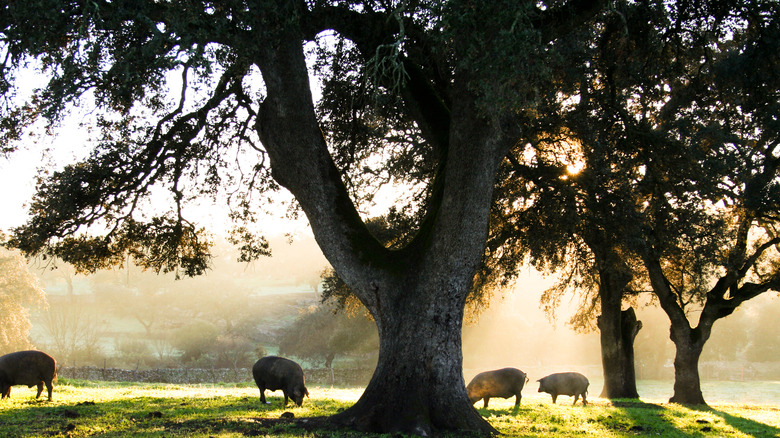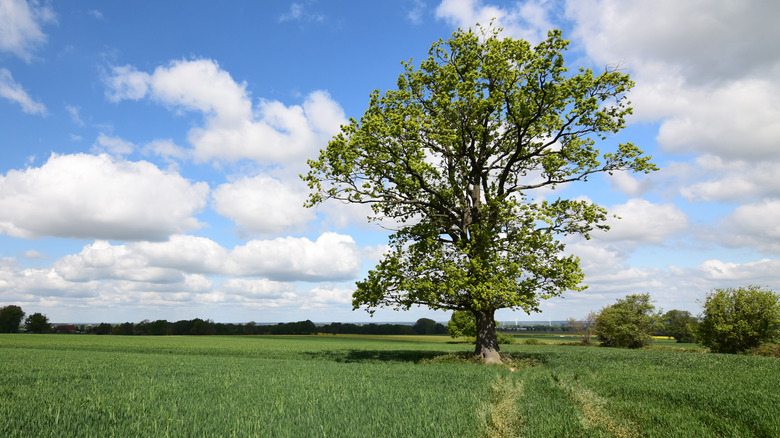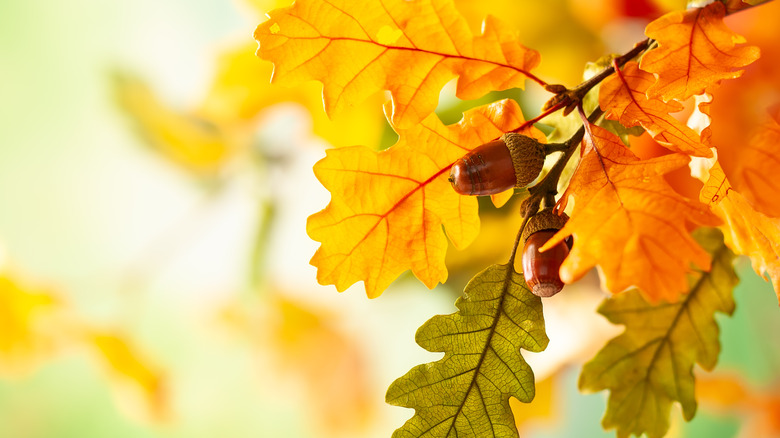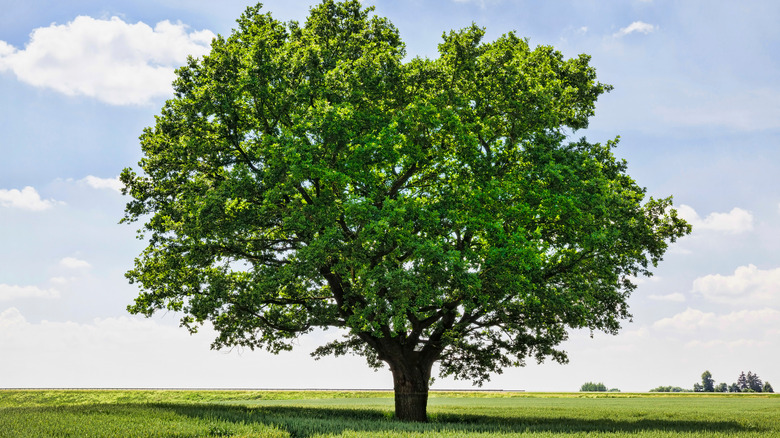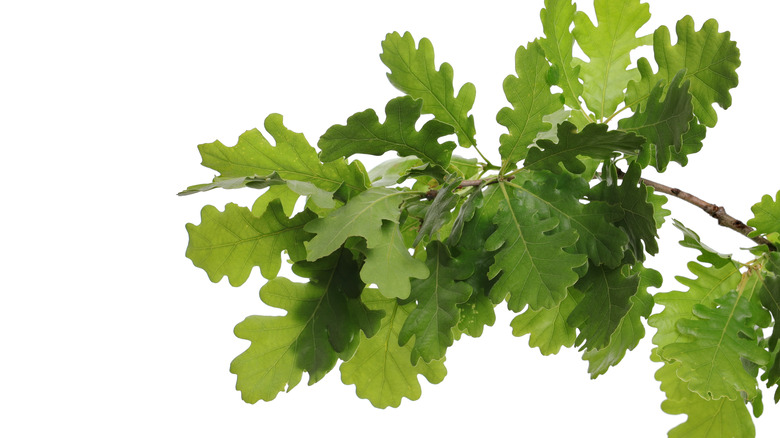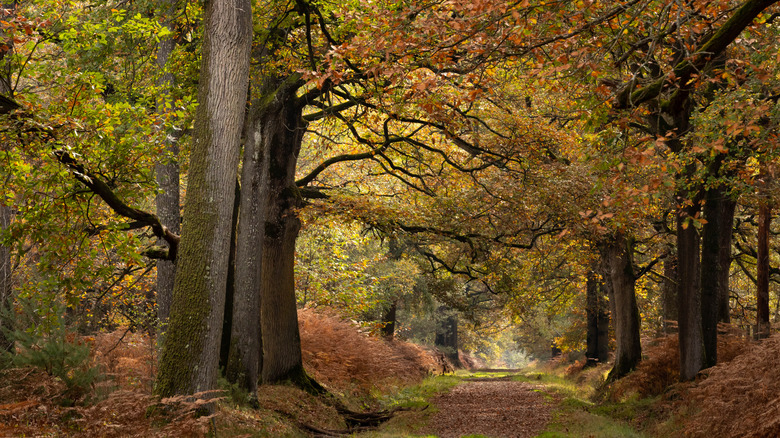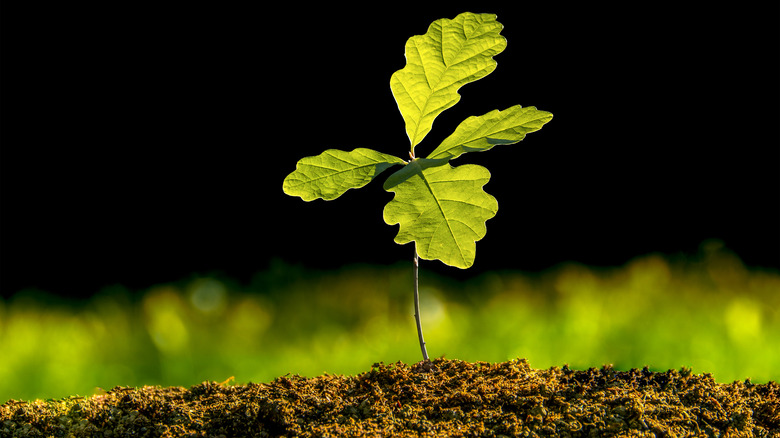How To Grow And Care For Oak Trees
The oak tree (Quercus), found along the Gulf of Mexico and Atlantic coasts from Texas to Virginia, is a symbol of the southern region of the United States, as Moon Valley Nurseries notes. The tree is recognized for the immense girth of its sprawling lateral branches, which can be three times as broad as its height. Oaks are often used as shade trees, specimen trees, or to form lovely allées.
If you want to plant this lovely behemoth, keep in mind that its hardiness zone is small. Also, you'll need a lot of space for it to expand into, both in height and width, and the pruning required to help it establish itself can be a challenge. Additionally, oak trees thrive in the southern climate because they prefer warm, moist conditions. They enjoy growing in full sun, which means at least six hours of direct sunshine per day. Allowing an oak tree to breathe — in terms of space — will benefit your landscaping. However, if you're growing other plants around an oak tree, ensure they're drought-tolerant and don't need to be watered in the summer.
How to use oak trees in garden
The oak tree has always held a special place in human civilization since early humans learned to recognize and use plants. For one, oak groves were often used in various rites by Druids in the United Kingdom, per Trees For Life. In addition, French winemakers are still utilizing oak wood barrels to create the best wine money can buy hundreds of years later (via Crush Wine XP). Again, oak trees that are large and widespread require a lot of space to thrive, so if you have a tiny garden or are searching for a tree to provide shade in your backyard, they should not be your first option. However, you won't find a better landscaping alternative than the oak tree if you have an expansive lawn or want to create a landmark on your property, Sciencing writes.
Oak trees have also long played a part in the lives of those who lived adjacent to an oak forest, offering shade and delicious acorns. Many of the traditional uses of oak trees and the cultures that encouraged them have vanished; others, on the other hand, are still living today. Because the oak wood is robust and solid, it resists termites and fungi well, making it perfect for planking, furniture, roof, and garden structures. Lastly, the oak tree's bark is the primary source of cork, a tannin used in leather tanning, and a key element in traditional medicine.
How to grow oak trees
If you want to cultivate an oak tree, you'll have to start from scratch. Here's how to grow an oak from an acorn in just a few simple steps. First, gather a few ripe acorns in the fall that are free of fungi and dents, Gardening Know How recommends. Then, remove the acorns' crowns and set them in a bucket of water to soak. Put the remaining acorns in a plastic bag and fill it halfway with damp potting soil, then seal and refrigerate it. Check the acorns often and add a few drops of water if the potting mix becomes dry. As soon as the acorns germinate — after around eight weeks — get a medium-size container with drainage holes and fill it with potting mix and the acorns.
After fully watering the pot, set it on a window sill facing south as the acorns require a lot of sunshine to sprout. Harden the seedlings when they are approximately 6 inches tall and have a pair of leaves developing at the top. In early spring, take them outside for a few hours each day. Next, dig a hole twice the width of the root ball and twice the depth of the oak sapling taproot. Fill the hole with soil and place the oak sapling in it. To ensure that the roots stay straight, pack the soil firmly. To encourage water retention, water the oak right away and cover the soil with a heavy layer of mulch.
How to care for oak trees
The live oak is unconcerned about its surroundings, but its sprawling size might cause damage to infrastructure if you don't plan for how big your tree will grow. If you walk around the southern part of the nation, you'll see that these behemoths tend to elevate sidewalks when put near streets. Setting up a pruning regimen will probably be the most challenging aspect of caring for a young southern live oak. However, Integrity Tree Pros says this practice ensures that your tree has the proper structure for clearance below its branches as well as the strength to last for the following four to nine centuries.
The live oak is a southern tree that thrives in heat and humidity and will perish if it is not exposed to the warm environment of its natural habitat in the USDA zones 8 through 10. It can adjust to a wide range of settings, but the temperature is non-negotiable, and although it thrives in direct sunlight, it may also develop well in moderate shade. To assist your oak in establishing itself, you'll need to water it weekly after you've planted it: Give it around 10 gallons of water per inch of trunk measured by gauging at knee height. Then, when established, you won't have to concern yourself with it running out of water since they are exceptionally drought-resistant.
Varieties of oak trees
While there are hundreds of types of oaks, Plant Snap writes, they are divided into two categories: red oak and white oak. Not all oak varieties can be grown in the backyard or garden, so here are a few of the most common oaks to consider.
-
"Water Oak Tree" (Quercus nigra): This oak type is well-known not only for its height of over 100 feet but also for its ability to keep its leaves well into the winter. The leaves have dark green hues and are spoon-shaped with spherical tips. The mature tree's bark is often scaly and almost black.
-
"Cherrybark Oak" (Quercus pagoda): This type of oak tree can reach 130 feet tall and has a rapid growth rate compared to other oaks, with bark that resembles that of a black cherry tree. The dark green glossy leaves have tiny hairs on the underside.
-
"Northern Red Oak" (Quercus rubra): The bright green leaves of this oak tree are lobed with sharp teeth towards the tip. When fully mature, the tree reaches a height of 90 feet. It has dark brown bark with gray streaks that run through the deep crevices.
- "Scarlet Oak" (Quercus coccinea): This is a medium-sized tree that may be grown in your yard and grows to be around 65 feet tall. C-shapes on the dark green leaves define the lobes, and the tree's bark is often dark gray with brownish streaks.
Are oak trees toxic?
Many people are astonished to learn that those lovely, shady oak trees in the backyard that everyone enjoys stretching out under, including the dog, can pose a threat to their pet. Symptoms of poisoning can include cramps, vomiting, constipation, diarrhea, sometimes bloody diarrhea, kidney failure, and even seizures, depending on the amount eaten. According to the Agricultural Research Service, the gallotannin found in most oak tree leaves, bark, and acorns cause poisoning by affecting pets and animals' gastrointestinal tract and kidneys. Oaks are poisonous for animals at any stage of development, but they are especially dangerous while the leaf and flower buds are barely budding in the spring.
However, humans can use its acorns in several different ways, as noted by Woodland Trust: They can be eaten whole, processed into acorn meal or flour, or ground into mush to extract the oil. You can also roast them for 15 to 20 minutes and season with salt for a tasty snack after you've successfully leached the tannins from your raw acorns. Many oak tree types also have edible leaves — generally, when they sprout in the spring. Some species' leaves can be eaten raw, while others must be cooked before being consumed. The bark of the oak tree is also extremely valuable and is widely used in medicine as an antibacterial and hemostatic, to treat toothaches and gastropathies, quiet inflammation, and heal burns.
How to transplant oak trees
Oaks can be tough to transplant; this is particularly true with white oaks. It isn't impossible, though: As soon as the leaves begin to unfold, you can transplant your seedling. However, ensure you shelter newly planted seedlings from the elements and wildlife. When deciding where to plant an oak, choose a suitable place. Not only must you select a site that is devoid of wildlife, but you must also pick a location that will allow your oak to flourish.
Furthermore, protect the sapling with a cage or fencing to keep animals like deer away. Ensure the fence is large enough for the oak to grow through, and remove it before the oak outgrows it. Don't fertilize the sapling until it's been in the ground for at least two years; however, if you're worried that you won't be able to plant your oak because you don't have excellent soil, a decent rule of thumb is to mix in some soil from underneath an existing oak tree with your own. This can aid in growth and provide the sapling with the nutrients it needs. An oak tree can be transplanted until it reaches a height of 5 to 8 feet: You will not severely harm the tree or the root during this phase, Home Affluence says. Any taller than that, and you risk killing the tree instead of effectively transplanting it.
